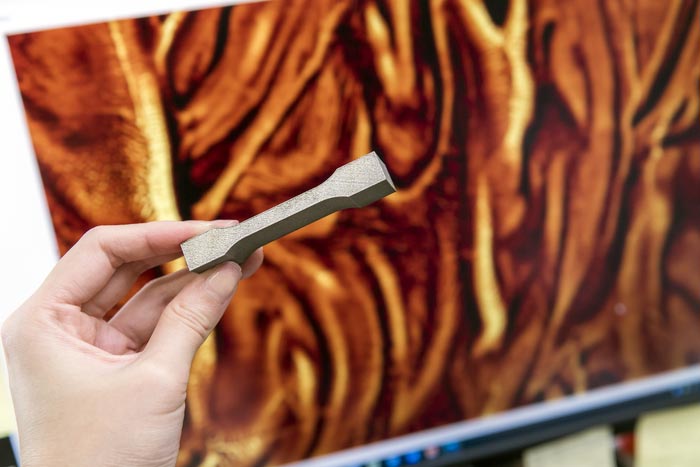Innovative design of titanium alloy with supreme properties by 3D printing

The new titanium alloy developed by City University of Hong Kong using 3D printing has lava-like microstructures that give rise to its excellent mechanical properties.
Credit: City University of Hong Kong
A research led by scientists from City University of Hong Kong (CityU) has successfully developed a super-strong, highly ductile and super-light titanium-based alloy using additive manufacturing, commonly known as 3D printing. Their findings open up a new pathway to design alloys with unprecedented structures and properties for various structural applications.
The research team was led by Professor Liu Chain-Tsuan, University Distinguished Professor in the College of Engineering and Senior Fellow of CityU’s Hong Kong Institute for Advanced Study (HKIAS). Dr Zhang Tianlong, a postdoc in the Department of Materials Science and Engineering (MSE), conducted the experiments. Their paper, to which President Way Kuo of CityU also contributed, was published recently in the prestigious scientific journal Science, titled “In situ design of advanced titanium alloy with concentration modulations by additive manufacturing“.
3D printing: not just a shaping technology
Most people consider 3D printing as a revolutionary technology that can produce machine parts with complex shapes within just one step. “However, we unveiled that it has important potential in designing materials rather than simply designing geometries,” said Dr Zhang, who completed his PhD at CityU under Professor Liu’s supervision earlier this year.
Metallurgists tend to think that a lack of uniformity in alloy components is undesirable because it leads to bad properties, such as brittleness. One of the key issues in the additive manufacturing process is how to eliminate this inhomogeneity during fast cooling. But Dr Zhang’s previous modelling and simulation study found that a certain degree of heterogeneity in the components can actually produce unique and heterogeneous microstructures that enhance the alloy’s properties. So he tried to put these simulation results into reality by using the additive manufacturing.
Designing unique microstructures
“The unique features of additive manufacturing provide us with a greater freedom in designing microstructures,” Dr Zhang explained, who is also the first author of the paper. “Specifically, we have developed a partial homogenisation method to produce alloys with micrometre-scale concentration gradients with the aid of 3D printing, which is unachievable by any conventional methods of material manufacturing.”
Their proposed method involves the melting and mixing of two different alloy powders and stainless steel powders using a focused laser beam. By controlling parameters like the laser power and its scanning speed during the 3D printing process, the team successfully created the non-uniform composition of the elements in the new alloy in a controllable way.
“In addition to the use of additive manufacturing, the composition of the two powder mixture is another key to creating the unprecedented lava-like microstructures with a high metastability in the new alloy,” said Professor Liu. “These unique microstructures give rise to the supreme mechanical properties, allowing the alloy to be very strong but ductile, and in light weight.”
Novel alloy: 40% lighter and super-strong
While stainless steel is generally 7.9 grammes per cubic centimetre, the new alloy is only 4.5 grammes per cubic centimetre, resulting in around 40% lighter weight. In their experiments, the titanium alloy with lava-like microstructures exhibited a high tensile strength of about 1.3 gigapascals with a uniform elongation of about 9%. It also had an excellent work-hardening capacity of over 300 megapascals, which guarantees a large safety margin prior to fracture and is useful in structural applications.
“These excellent properties are promising for structural applications in various scenarios, such as the aerospace, automotive, chemical, and medical industries,” said Professor Liu.
“As the first team to use 3D printing to develop new alloys with unique microstructures and properties, we will further apply this design idea to different alloy systems to further explore other properties of the new alloys,” he added.
Professor Liu, Dr Yang Tao from MSE, and Professor Wang Yunzhi from The Ohio State University are the paper’s corresponding authors. Apart from President Kuo, other CityU researchers who participated in the research included Dr Luan Junhua, Dr Wang Anding and Dr Kong Haojie. Other collaborators are Professor Huang Zhenghua from Guangdong Academy of Sciences and Dr Wang Dong from Xi’an Jiaotong University.
The research was supported by CityU, HKIAS, the National Key Research and Development Program of China, the National Natural Science Foundation of China, Guangdong Academy of Sciences, and the US National Science Foundation.
Journal: Science
DOI: 10.1126/science.abj3770
Method of Research: Experimental study
Subject of Research: Not applicable
Article Title: In situ design of advanced titanium alloy with concentration modulations by additive manufacturing
Article Publication Date: 21-Oct-2021
Media Contact
P.K. Lee
City University of Hong Kong
pikklee@cityu.edu.hk
Office: 852-344-28925
All latest news from the category: Materials Sciences
Materials management deals with the research, development, manufacturing and processing of raw and industrial materials. Key aspects here are biological and medical issues, which play an increasingly important role in this field.
innovations-report offers in-depth articles related to the development and application of materials and the structure and properties of new materials.
Newest articles

Decoding Cancer: 40 Years of Breakthroughs in Genetic Research
Cancer in children and adolescents is rare. Nevertheless, malignant diseases are still one of the most common causes of death in this age group. Survivors of childhood or adolescent cancer…

Let’s Think Before the First Drink: How Early Substance Use Might Lead to Brain Structure Differences Among Adolescents
Many differences appeared to exist prior to any substance use, pointing to the role brain structure may play in substance use risk, NIH-supported study suggests. Studies reveal factors that expose…

Combating Kidney Cancer Using Enhanced Immunotherapies
Medical University of South Carolina Hollings Cancer Center researcher receives Department of Defense Early Career Scholar Award to improve immune therapies by targeting resistant kidney tumors. A Medical University of…



